
|   |

|   |
 e-mail: leelakaverivenkat@gmail.com A towering post-Independence presence in Indian art history and aesthetics is no more October 8, 2020 Indian scholars and art lovers exploring Indian art and aesthetics may not, for years have the benefit of a towering personality in their midst to equal Kapila Vatsyayan. Unlike the Greco-Roman approach of western scholarship in studying art, Kapila Vatsyayan looked at the holistic nature of Indian art totally from an Indian point of view. She believed that other traditions of art could be viewed through the Indian window. Studying Vastu-Sastra, Silpa Sastra and Sangit Sastra, her prodigious intelligence was able to decipher inter connectivity among all disciplines of India, which in their multi-layered complexity evolved with a give and take, taking off from the Indian world view which looked at no aspect of life - inanimate, animate, geological, biological, matter, energy, sense organs or sense perceptions - as being in 'absolute autonomy and isolation.' Spatially and temporally key concepts and seminal ideas permeate all art and literary traditions. 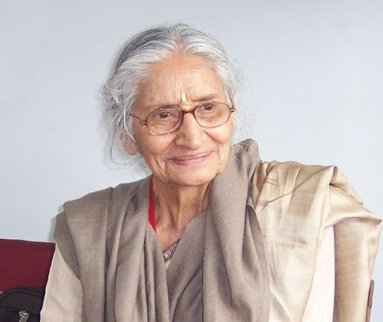 Kapila Vatsyayan "Micro-Macro categories are evolved within a flexible fluid structure and transformative processes, throughout recognising that there is a dimension beyond measure and classification." (Quote from Kapila Vatsyayan's 'Metaphors of India'.)What the mystic physicist Fritjof Capra had sensed sitting beside the sea watching the waves and sands in a ceaseless flow of energy through interplay of particles in the Universe, as acts of creation and destruction artistically represented in the icon of Nataraja, Ananda Coomaraswamy in his study of Indian arts had recognised as the ultimate Bindu in life from which everything takes off - as a metaphor of the Universe in motion - cosmic activity here being the central motif of the dance of Nataraja. This line of linking acts from different spheres, Kapilaji carried it to its highest point, in her Metaphors of the Indian Arts. For Kapila Vatsyayan, Man was only one among living matter and her thoughts reflected Man in Nature and not Man and Nature. She had the perspicacity of vision which could draw parallels between the Nata Sankirtana, the Vedic Yagna and a temple ritual which few scholars could. Art as a physical, mental, spiritual endeavour for her was a discipline, a sacrifice and a Yoga at the same time. She believed that art was Form with surcharged consciousness. The impersonalization of the subjective whether dealing in stone, or sculpture, or painting, or music, or drama in the concept of 'rasa' in Buddhist, Jain, and Hindu thought was never better explained than by her. The aesthetic experience which Bharata's Natya Sastra dealt with through technique, with later commentators adding the metaphysical experience and with Abhinavagupta for whom the duality of subject and object disappeared with a state-of- being evoked unlike any other experience (Tanmayibhavana-yogyata), was explored in all its dimensions in Kapilaji's innumerable books. She seemed blessed with a special third eye when it came to spotting ideational motifs of Indian aesthetics which have travelled across vast geographical areas in South East Asia. Even her exacting guru Acharya Vasudev in Benares under whom she did her PHD, was bowled over when he saw that the 5000 odd photographs of sculptures he had asked to arrange chronologically had been perfectly done. When she explained that she did it by looking at the positioning of the feet position on the ground and posture, particularly of the lower part of the body, he acknowledged that he had learnt something he did not know. Even while Sanskrit scholars felt that trying to master history of Indian sculpture and architecture without a sound Sanskrit background was a herculean task, Kapilaji showed them that she had the in-depth understanding and scholarship needed for the task. Kapilaji as bureaucrat rose up to be Secretary to the Government of India, Department of Arts; a member of the Rajya Sabha, and member of the UNESCO Executive Board as well as President and Life Member of the India International Centre. As chairperson of the Centre's Asia Project, her immense desire was to forge understanding among nations through cultural understanding - a task she pursued with unfailing zeal in spite of the infirmities of age during the last few years. Her work in reviving and restoring the Institutes of Tibetan Buddhist Studies with the Sikkim Institute of Tibetology was considerable. Tibetan Studies were given a place in Varanaseya Sanskrit Vidyalaya. For all her efforts, Kapilaji held a very special position in the heart of the Dalai Lama who in a light vein addressed her as 'Mother.' 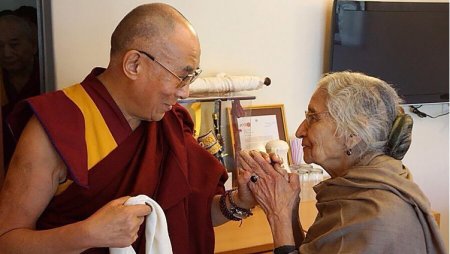 Kapila Vatsyayan with the Dalai Lama The IGNCA that Kapilaji headed for years, in the manner of the Smithsonian Institute, was designed in a way suiting her approach of all sciences, humanities and arts coming together, "each with its own integrity, but organically interlinked with the other." Even Stella Kramrisch wrote to her on reading about the concept that this attempt to make 'the world a cosmos of the inner life and mind' was giving birth to a new realisation. Growing up as a youngster Kapilaji's experience with dance began with learning Oriental Dance. While performing in the only available auditorium of South Indian Society in Delhi at the time, presenting Ardhanariswar inspired by Nandlal Bose's paintings, young Kapila was witnessed by Kathak maestro Achhan Maharaj, who along with Hafiz Ali Khan and Mushtaq Hussein Khan had been appointed teacher in the New School of Hindustani Music and Dance set up by Nirmala Joshi, a dynamic teacher of physiology from Indraprashta School where Kapila studied. Greeted by Achhan Maharaj Guru with the words that she danced very well but needed proper training, Kapilaji began learning Kathak under him, to become a gandabandh disciple of this 'human repository of classical dance Kathak.' Not many know that she danced in 1954 in the National Dance Festival in ballets of Kumarsambhav and Braj Leela organised by SNA. As a matter of fact, with Achhan Maharaj's sudden demise in 1947, Kapilaji was responsible for getting Pandit Birju Maharaj to Delhi, at a very young age to conduct classes in the School of Hindustani Music and Dance, apart from providing the boy teacher with a vital link to the prematurely departed father's legacy. She also became later, a very serious student of Manipuri, learning from Ojha Amubi Singh, the tallest among Gurus of this tradition. Her interactions with Meenakshisundaram Pillai gave her new insights into Bharatanatyam. I clearly recollect in the 1960's her going to Pandara Park to the flat of Lalita Shastri who had graduated from Kalakshetra and set up teaching classes in Delhi. Kapilaji's all-pervading interest even took her to Cheruthuruthi to Kalamandalam and Kerala's dance enthusiasts who are not known to easily admit non-Keralites into the Kathakali Brantha fold, always held her in great respect. She even looked at Bhagavata Melam closely. With this background, it was no wonder that she hated being addressed as just "Scholar Kapilaji!" She would retort, "This Kapilaji has used her body and knows how it works." So unlike dance practice and theory operating in separate orbits, she brought to bear on her research knowledge of both theory and practice. 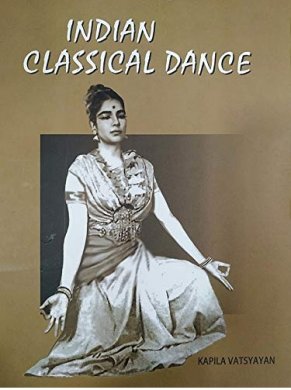 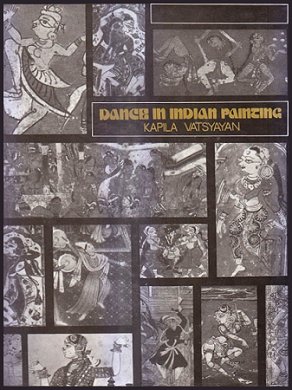 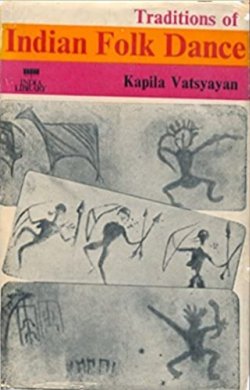 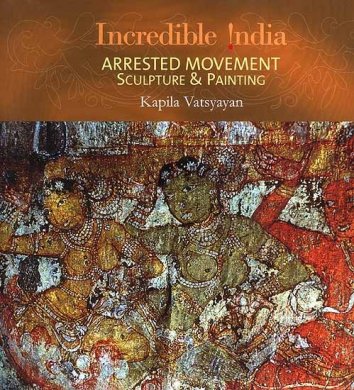 Travelling with Juana gave Kapilaji an understanding of western Modern Dance of German expressionist Mary Wigman, of Hanya Holm, of Alwin and Nikolais. She visited Martha Graham's studio to see her doing abdominal contractions and relaxation. She even witnessed La Meri teach dance. Kapilaji's was an unusual childhood growing up in the early years close to figures like Nobel Laureate Gurudev Rabindranath Tagore and legendary Nandlal Bose. During later years, interacting with the likes of Aruna Asaf Ali, Dr. Grace Morley, Stella Kramrisch, Rukmini Devi Arundale, Kamaladevi Chattopadhyay and many other stalwarts of this period along with Prime Ministers who often consulted her on matters of culture, along with the ups and downs of life during the Nationalist struggle, opened her to multiple life experiences, leading to an open mind. The shift from Loretto School in Calcutta was to the very different world of Indraprastha High School in Delhi with the school bus passing through havelis and red light area of Chauri Bazar, in a world where Baniyas of the Katras, Kayasthas, Muslims, migrants from Punjab, Munshis who were traders, Kashmiris of Sita Ram Bazar - were all living together and in scattered communities. It was a world of mujras, kothas, baithaks, taleem of gharanas in closed environs and one found Ustads of Rampur and Gwalior gharanas - like Mushtaq Ali Khan of Rampur. Sensitised to music too, she was instrumental in ensuring that the great Bismillah Khan's shehnai was heard all over India and the world and not just in the area round the Viswanath Mandir in Benares. Again to Kapilaji, the credit for making Balasaraswati's magical art known to the world as a bureaucrat in the Department of Arts - while ignoramuses kept hooting for youth and beauty only to be sent abroad. Bala remained the greatest artist in Kapilaji's mind - and even in her house, a large photograph of Bala has pride of place adorning the wall. Though a Kathak loyalist, when I asked her about Shambhu Maharaj's abhinaya prowess and what she thought of it, she said after a while "Great.......But Bala was special... She was something else!" Apart from the change which came about in Kashmir where the family had spent such wonderful days, Kapilaji was a witness to how art, which she believed was the best cementing force between different communities, could not always fight other forces of schism. Bismillah Khan Saheb was disallowed from playing the shehnai outside the temple before the prayers inside began. She saw how Yesudas, with all his music would not be allowed to sing inside the temple in Kerala. She saw 'Thiyas' kept out of temples. With all the coming together of all communities that she extols in the arts, she was realistic enough to realise that differences too have been were very much a part of the Indian socio/cultural scene. Kapilaji in passing once mentioned to me how her mornings were spent with Bala in Chennai and afternoons with Rukmini Devi in Kalakshetra. When asked as to how she reconciled the two approaches, she said that one had to remember they represented different times with societal attitudes proving too strong to fight - and artistically she had respect for both. She also said she did not speak about one to the other. A critic from Odisha recently said to me, "I read Kapilaji's description of Chhau dance- which nobody had been able to explain like she did - and overnight became a fan of her! If I had to understand the theory behind dances of Odisha, I went to Kapilaji's writings." It required a Kapilaji to explain Surendranath Jena's approach to Odissi (he was her teacher) for in the region of Odissi's birth, Jena's approach to the dance had few takers. Born to a Punjabi family of activists and high achievers in different fields, who migrated to Kashmir, Kapilaji's maternal grandfather Chiranjeet Lal, a social reformer and Arya Samaj leader, who eschewed caste distinctions deciding to never serve the British, established a business empire building bridges from Uri to Baramulla and finally renounced all to become a sanyasi. Influencing the growing child Kapila was dynamic aunt Anjana in politics, very close to Acharya Narendra Deva, who went to jail and set up Dastkar, a woman's unit in Meerut , now known as Urmila Sastri Dastkari School. Kapilaji's uncle Dharmendra Shastri was an authority on Buddhism. Kapilaji's own mother Satyawati in Srinagar was galloping horses while carrying Kapila. She was the person who apart from door to door collection of funds goaded her friend Vinay Chandra Maudgalya, to start a school in Delhi for Hindustani music training, promising him two immediate students in her son and daughter, which led to the setting up of Delhi's Gandharva Mahavidyalaya, responsible for training so many students of Hindustani classical music today. In such a family, where women had freedom, Kapilaji grew up with an open mind. Her idea of woman was based on Goddesses like Durga and Kali conceived as the vanquisher of conflicts even male Gods could not control, and not as the deification of beauty or as sin as conceived in western theology. I remember the many evenings at the IGNCA when after a talk by some scholar with questions raised in the discussions following the talk, Kapilaji taking the floor finally and mentioning a couple of points which summed up everything as the inevitable last words - so appropriate were they. People resented and were not always happy about her importance. But the fact remained that there was nobody with the depth of scholarship to be able to debate with her on any point. I recollect during an SNA dance festival, a morning session with highest of dignitaries also attending , Kalamandalam Gopi in the role of Nala in Unnayi Warrior's Nala Charitam performing the famous sringar scene when he describes the beauty of Damayanti. Some of the abhinaya variations he spun round the main line were so exquisite evoking many expressions of praise. But when Kapila Vatsyayan said, "Gopi, excellent!" one literally saw the dancer visibly expand in happiness and pride, for one word from her meant everything! Also coming to mind is the ICCR sponsorship at the Kamani of a male/female Contemporary Dance troupe from Denmark, who had the audience in raptures. When many in the audience rushed backstage after the performance to greet the dancers, gushing how wonderful they were, Kapilaji just walked up and said, "I loved your technique and the way you used your body." She went into an analysis of why she thought they were exceptional and the couple looked dazed with shock that somebody from India should be able to decipher their approach to movement with such clarity. "Laban School of Movement Studies!" she announced proudly. She could always pick on the salient feature of each performance and one realised how trained the eyes and mind were! It is going to be difficult to imagine the IIC without her presence which always created a special aura. An exacting boss not given to much praise, she did not suffer fools gladly and made it known - thereby creating resentment in people. But one cannot forget that she led by example not sparing even herself, working till the last moment of her life. The last few years, she had developed the habit of ringing up people on her own to tell them about points and aspects she found particularly perspicacious in their writings. Needless to say these were times when one felt one was walking on air! For people who interacted with her, and the members of the IIC programme section, there will be a feeling of terrible emptiness. Hopefully her spirit will live on, in the experience gained under her for so many years.  Writing on the dance scene for the last forty years, Leela Venkataraman's incisive comments on performances of all dance forms, participation in dance discussions both in India and abroad, and as a regular contributor to Hindu Friday Review, journals like Sruti and Nartanam, makes her voice respected for its balanced critiquing. She is the author of several books like Indian Classical dance: Tradition in Transition, Classical Dance in India and Indian Classical dance: The Renaissance and Beyond. Post your comments Please provide your name and email id when you use the Anonymous profile in the blog to post a comment. All appropriate comments posted with name and email id in the blog will also be featured in the site. |